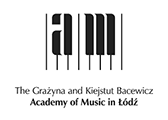Entrance examination:
- major exam (major instrument)
- and basic exams: independent preparation of a piece, sight reading, aural training
Dates of entrance exams: 20th - 29th June 2015
Fee for the entrance exam: 130 PLN
A list of required documents for candidates for the first cycle studies is available at: http://www.amuz.lodz.pl/lifemotion/en/home-en-gb/8-system-en-gb/149761-s...
All candidates are required to apply on-line through the website: www.amuz.lodz.pl
Instrumental Faculty
• field of studies: INSTRUMENTAL STUDIES / first cycle full-time studies (3 years) majors: violin, viola, cello, double bass, flute, oboe, clarinet, bassoon, saxophone, horn, tuba, trombone, trumpet, percussion, harp, guitar, accordion.
Studies addressed to musically talented candidates, possessing certificate of secondary education, who want to continue music education and improve their skills in the field of playing a chosen instrument. Candidates must demonstrate both ability to play the instrument and general music knowledge at the level of secondary music school.
GRADUATE PROFILE
The graduate receives a diploma of graduation of the 1st cycle studies in the scope of playing a chosen instrument and is entitled to apply for the 2nd cycle studies. The graduate possesses qualifications to work as a musician instrumentalist: soloist and chamber musician and lead didactic classes in primary music schools.
Pedagogical qualifications, in accordance with standards of education preparing to perform the job of a teacher, are acquired through parallel learning in Pedagogical Study.
The graduate of the 1st cycle studies possesses the following competences:
• possesses knowledge in the scope of basic repertoire related to his/her major as well as performance and artistic abilities, due to which he/she is able to transfer information and artistic ideas, understandable for specialists and people not connected to music;
• can freely and creatively use the means of artistic creation within his/her major, can use possessed knowledge in the scope of music history, literature and broadly understood cultural context to create his/her own artistic ideas; taking into consideration the newest trends in art, he/she is able to prepare interpretation of a music piece and perform it in public; possesses abilities enabling to carry out joint artistic projects in chamber ensembles and various types of orchestras;
• possesses communication skills and ability to cooperate with other artists in order to carry out joint projects.
ENTRANCE EXAMS
• MAJOR EXAM
MAJOR INSTRUMENT
Performance of the programme at the level of secondary music school diploma.
VIOLIN
1. J. S. Bach – two parts of a chosen sonata and partita for violin solo.
2. One caprice.
3. A concerto (part 1 or 2 and 3).
VIOLA
1. J. S. Bach – two parts from a chosen cello suite (transcribed for viola solo) or J. S. Bach – two parts of chosen sonata or partita for violin solo (transcribed for viola solo)
2. One caprice.
3. A concerto (part 1 or 2 and 3).
The programme performed on viola. The Faculty Recruitment Board may allow to perform the programme on violin upon the request of a candidate who declares willingness to begin studies in the major – viola (and complies with other requirements listed in recruitment regulations).
CELLO
1. J. S. Bach – one part of a suite for cello solo.
2. A caprice – A. Piatti or two-sound etude.
3. Two contrasting parts from sonata or concerto (part 1 with cadence or part 2 and 3).
DOUBLEBASS
1. Two same-tone scales (major, minor), passages.
2. A virtuoso piece (etude, caprice, tarantella or variations).
3. Two parts of sonata.
4. A concerto (part 1 and 2 or part 2 and 3).
5. A cantilena piece.
WIND INSTRUMENTS (flute, oboe, clarinet, bassoon, saxophone, horn, trumpet, trombone, tuba)
1. Major and minor scales in different variants.
2. One-two technical pieces (etude, caprice).
3. A concerto or sonata (representing different styles).
4. A free work.
GUITAR
1. One sonata.
2. Two etudes with various technical issues.
3. A Baroque piece (suggested J. S. Bach).
4. Two free works.
HARP
1. Part 1 of a concerto for harp.
2. A concert etude.
3. A Baroque piece.
4. A sonata, suite or fantasia.
PERCUSSION
1. Two works for melodic instruments: one for vibraphone, second for marimba or xylophone.
2. One melodic work (in transcription) from the Baroque or classicism.
3. Kettle-drums – tremolo and a piece (solo or with accompaniment).
4. Drumroll – tremolo and a piece (solo or with accompaniment).
5. A set of instruments – w chosen piece.
ACCORDION
1. A work by a composer from Baroque including a 3-/4- voice fugue.
2. D. Scarlatti – a sonata.
3. Original cyclic work or variations (whole).
4. Two free pieces, including one virtuoso piece.
One from the chosen works must be an original composition for accordion (programme must be performed from memory).
• BASIC EXAMS
INDEPENDENT PREPARATION OF A PIECE (during one hour).
SIGHT READING
AURAL TRAINING
1. A written test Filling in the missing sounds in dictations: 1-voice (atonal), 2-voice (polyphonic) and 4-voice (harmonic) and short exercises on recognition and familiarization of simple sound structures.
2. An oral test Reading notes aloud and familiarization with basic elements of music (scales, intervals, chords)

